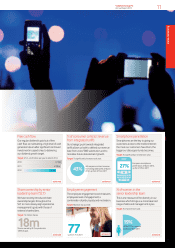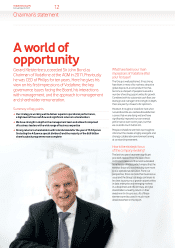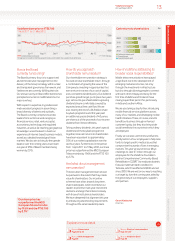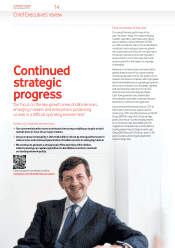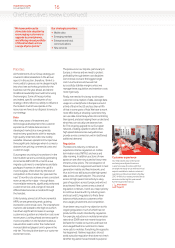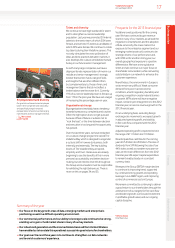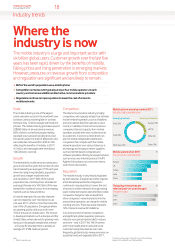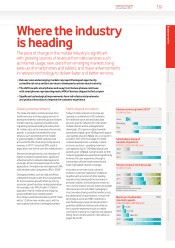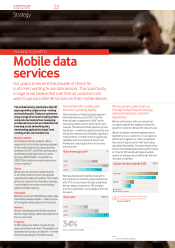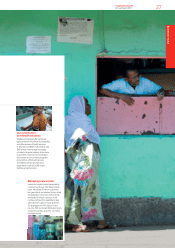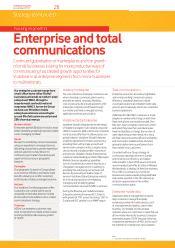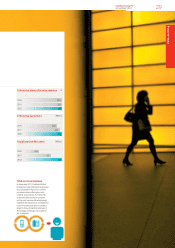Vodafone 2012 Annual Report Download - page 21
Download and view the complete annual report
Please find page 21 of the 2012 Vodafone annual report below. You can navigate through the pages in the report by either clicking on the pages listed below, or by using the keyword search tool below to find specific information within the annual report.
Business review Performance Governance Financials Additional information
19
Vodafone Group Plc
Annual Report 2012
Growing revenue streams
The share of industry mobile revenue from
traditional voice and messaging services in
developed markets is declining due to relative
market maturity, ongoing competitive and
regulatory pressures leading to lower prices
formobile calls, and a slow pace of economic
growth. In contrast the demand for data
services, such as internet on the mobile,
isgrowing rapidly. In 20061 data services
accounted for 6% of industry mobile service
revenue, in20111it reached 20%, and it is
expected to rise further over the medium term.
Demand is being driven by a combination of
higher smartphone penetration, signicant
enhancements to network data speed and
coverage, and an increased range ofmobile
applications. Smartphones now represent 39%
of all handset sales compared to 8% in20061.
Emerging markets, such as India and Africa,
represent the regions with the most potential
for future revenue growth driven bystrong
economic growth and low mobile penetration.
For example, only 74% of India’s 1.2 billion
population have a mobile phone implying
good potential future market growth.
According to external estimates by 20151 there
will be 1.5 billion new mobile users, and the
vast majority will be from emerging markets.
Technological innovation
Today’s mobile networks in Europe are
typically a combination of 2G networks
for traditional voice, text and basic data
services, and 3G networks for high speed
mobile internet access and application
downloads. 3Gmaximum data downlink
speeds are already up to 43 Mbps (with typical
userspeeds of up to 6 Mbps). 4G, orlong-term
evolution (‘LTE’), the next stage ofmobile
network development, is already in place
in some countries – providing maximum
user speeds of up to 150 Mbps (typical user
speedsup to 12 Mbps). Going forward, further
network upgrades are expected to signicantly
enhance the user experience through a
combination of both faster networks and
widerhigh speed network coverage.
Innovation in services is also critical to
enhancecustomer experience. Vodafone,
together with a number of other leading
operators, has developed the next wave in
personal mobile communications known as
rich communication services which will enable
data services such as instant messaging or
chat, live video sharing and le transfer across
any device and on any network, in much the
same way as voice and SMS. Vodafone is
alsodeveloping a range of new services to
generate additional revenue and enhance
thecustomer experience such as mobile
commerce, machine-to-machine and operator
billing, which are discussed in more detail on
pages 30 and 31.
Where the industry
isheading
The pace of change in the mobile industry is signicant
with growing sources of revenue from data services such
asinternet usage; new users from emerging markets; rising
take-up of smartphones and tablets; and major advancements
in network technology to deliver faster and better services.
a Data services and emerging markets represent the largest opportunity
astraditionalvoice andtextservices in developed countries reach maturity
a The shift towards smartphones and away from feature phones continues
withsmartphones representing nearly 40% of devices shipped in the last year
a Signicant technological improvements have led to faster data networks
andproduct innovation toimprove the customer experience
82006
2010
2011
21
39
Smartphone share of
handset shipments
Industry data calendar year
%
492010
2011
2012
43
38
28
30
33
23
27
29
Service revenue from key areas
Vodafone data
Emerging markets
Mature market data, xed and other
Mature market mobile voice
%
–4.0Voice
Messaging
Data
+4.4
+22.2
Fixed +5.4
Service revenue growth 2012*
Vodafone data
%
14.4 (3G)
2007
2008
2009 28.8 (3G)
150 (4G)
2010
2011 150 (4G)
Maximum mobile data
downlink speeds
Industry data calendar year
Mbps
7.2 (3G)
43.4 (3G)




